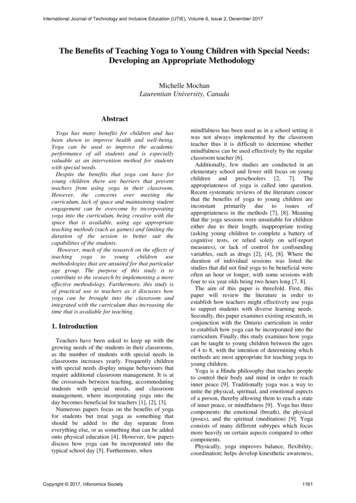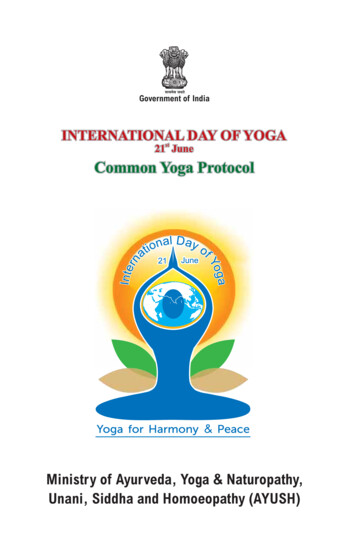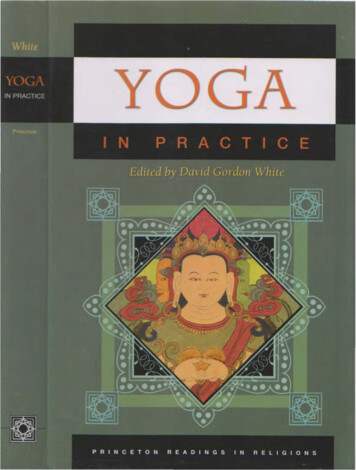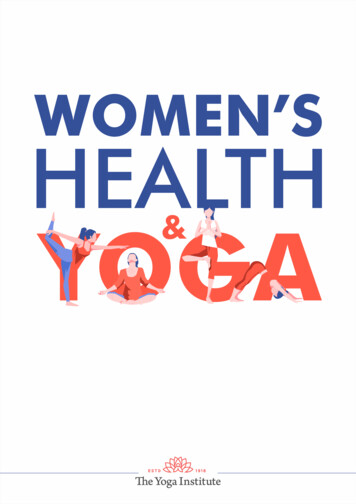
Transcription
International Journal of Technology and Inclusive Education (IJTIE), Volume 6, Issue 2, December 2017The Benefits of Teaching Yoga to Young Children with Special Needs:Developing an Appropriate MethodologyMichelle MochanLaurentian University, CanadaAbstractYoga has many benefits for children and hasbeen shown to improve health and well-being.Yoga can be used to improve the academicperformance of all students and is especiallyvaluable as an intervention method for studentswith special needs.Despite the benefits that yoga can have foryoung children there are barriers that preventteachers from using yoga in their classroom.However, the concerns over meeting thecurriculum, lack of space and maintaining studentengagement can be overcome by incorporatingyoga into the curriculum, being creative with thespace that is available, using age appropriateteaching methods (such as games) and limiting theduration of the session to better suit thecapabilities of the students.However, much of the research on the effects ofteaching yoga to young children usemethodologies that are unsuited for that particularage group. The purpose of this study is tocontribute to the research by implementing a moreeffective methodology. Furthermore, this study isof practical use to teachers as it discusses howyoga can be brought into the classroom andintegrated with the curriculum thus increasing thetime that is available for teaching.1. IntroductionTeachers have been asked to keep up with thegrowing needs of the students in their classrooms,as the number of students with special needs inclassrooms increases yearly. Frequently childrenwith special needs display unique behaviours thatrequire additional classroom management. It is atthe crossroads between teaching, accommodatingstudents with special needs, and classroommanagement, where incorporating yoga into theday becomes beneficial for teachers [1], [2], [3].Numerous papers focus on the benefits of yogafor students but treat yoga as something thatshould be added to the day separate fromeverything else, or as something that can be addedonto physical education [4]. However, few papersdiscuss how yoga can be incorporated into thetypical school day [5]. Furthermore, whenCopyright 2017, Infonomics Societymindfulness has been used as in a school setting itwas not always implemented by the classroomteacher thus it is difficult to determine whethermindfulness can be used effectively by the regularclassroom teacher [6].Additionally, few studies are conducted in anelementary school and fewer still focus on youngchildren and preschoolers [2, 7]. Theappropriateness of yoga is called into question.Recent systematic reviews of the literature concurthat the benefits of yoga to young children areinconstant primarily due to issues ofappropriateness in the methods [7], [8]. Meaningthat the yoga sessions were unsuitable for childreneither due to their length, inappropriate testing(asking young children to complete a battery ofcognitive tests, or relied solely on self-reportmeasures), or lack of control for confoundingvariables, such as drugs [2], [4], [8]. Where theduration of individual sessions was listed thestudies that did not find yoga to be beneficial wereoften an hour or longer, with some sessions withfour to six year olds being two hours long [7, 8].The aim of this paper is threefold. First, thispaper will review the literature in order toestablish how teachers might effectively use yogato support students with diverse learning needs.Secondly, this paper examines existing research, inconjunction with the Ontario curriculum in orderto establish how yoga can be incorporated into thecurriculum. Finally, this study examines how yogacan be taught to young children between the agesof 4 to 8, with the intention of determining whichmethods are most appropriate for teaching yoga toyoung children.Yoga is a Hindu philosophy that teaches peopleto control their body and mind in order to reachinner peace [9]. Traditionally yoga was a way tounite the physical, spiritual, and emotional aspectsof a person, thereby allowing them to reach a stateof inner peace, or mindfulness [9]. Yoga has threecomponents: the emotional (breath), the physical(poses), and the spiritual (meditation) [9]. Yogaconsists of many different subtypes which focusmore heavily on certain aspects compared to othercomponents.Physically, yoga improves balance, flexibility,coordination; helps develop kinesthetic awareness,1161
International Journal of Technology and Inclusive Education (IJTIE), Volume 6, Issue 2, December 2017and motor skills [9]. Emotionally, yoga helpschildren recognize and control their emotions andimprove emotional regulation, which helpsdevelop empathy and provides them with tools tocalm down if they are upset or angry [2]. Socially,yoga improves relationships among peers bybuilding a community of mutual trust and respect;children who can identify and explain theiremotions are better able to communicate withothers [2], [3]. Developing empathy fosters agreater understanding and appreciation for theirpeers, thus fostering stronger social ties [3].Mentally, yoga improves concentration, focus, andcreativity. The development of such skills fostersresilience and teaches children the coping skillsnecessary to encourage mental wellbeing. Thus,yoga allows children to explore and develop theiridentity [9].In Canada, the average person starts school atage 6 with the option to start kindergarten at theage of 4, the school day lasts approximately 6hours with students spending a minimum of 12years in school. As a result, school is one of theprimary means of socialization and has asignificant role in shaping people’s lives [8].Consequently, schools have the ability to teachstudents about health and resilience early so theycan form meaningful lifelong habits that positivelyimpact their health over their lifespan [8, 9]. Ifstudents are to learn they must be healthy bothmentally and physically; and research has longestablished that health and academic performanceare closely related [9]. Therefore, it is crucial todevelop and investigate programs that improve theoverall health and development of children.2. Literature ReviewVarious articles cite the physical and mentalbenefits of yoga. Yoga is a means for improvingstudents’ academic performance, concentration,and attention, which help children learn and retainnew information [1], [2], [5], [6], [8]. Somestudies suggest that yoga can improve the bloodflow to the frontal lobe, thus improving executivefunctioning [8]. Low executive functioning is amain component of many developmental andlearning disabilities [1], [7], [9]. Improvingexecutive functioning improves concentration andmemory, boosting the academic performance of allstudents [2], [5], [8].The greatest barrier to implementing yoga in theclassroom is the pressure to teach to thecurriculum and the lack of time teachers haveavailable [6]. This barrier can be overcome byintegrating yoga into the curriculum. Yoga can beintegrated into the curriculum to facilitate teachingmovement competence and emotional regulation,two key aspects of the physical education andCopyright 2017, Infonomics Societyhealth curriculum [2, 10]. Nevertheless, yoga isnot limited to meeting the expectations of thehealth curriculum. Depending on how the lessonsare designed yoga can meet a variety ofcurriculum expectations in different subjectsacross both the kindergarten and primarycurriculum.Yoga can also be used as a classroommanagement tool, in addition to setting the tone ofthe class. A study by Hassar found that yoga had asubstantial effect on establishing the atmosphereof the classroom [6]. Yoga was beneficial forregaining the attention of students and resettingthe classroom environment and tone in acomparatively short period of time [6]. Yoga cancreate a calm and peaceful environment andrefocus student’s attention towards a more focusedlesson when transitioning between subjects or afterbreaks [6]. Many students struggle during times oftransitions, especially children with conductdisorders, Autism and ADHD as they are typicallya time when a classroom becomes chaotic [6].Yoga is of particularly beneficial tool forclassroom management during this time as it canhelp ease the tone of the class into a more peacefulstate, allowing teachers to continue with the lessonmore readily [6].Students need to be taught the foundations ofmindfulness at an early age, to allow thesepractises to become tool that foster resilience. Theearlier students learn these practices, the more theybenefit in the future.2.1 How yoga meets diverse learning needsResearch suggests that yoga can be used to helpchildren diagnosed with Autism SpectrumDisorder (ASD) [4], [5], [7]. Yoga is uniquelysuited to help children with ASD learn social skillsas it was found that students with ASD are morereceptive to interventions which place an emphasison movement and sound [4]. As yoga incoprtaterepetitive movement which is proven to calmchildren with ASD, this study suggests that yogainterventions could result in a higher level ofengagement when compared to more traditionalinterventions for Autism and thus may be moreeffective [4].Furthermore, children with ASD often interpretinput from muscles easier than other forms ofsensory input (e.g. hearing, sight) and as such mayhave an easier time learning yoga [4]. Developinglanguage and social skills early is critical for anychild and has beneficial long-term effects on theoutcomes for children, particularly those affectedby ASD.Yoga is often taught through imitation, which isa critical skill for all children and one that manychildren with Autism lack; continuous practice of1162
International Journal of Technology and Inclusive Education (IJTIE), Volume 6, Issue 2, December 2017imitation in young children will improve languageoutcomes, and social skills [4]. A study conductedby Porters, J (2013) found that children withAutism who participated in daily yoga sessionsused more verbal communications, socializedmore with peers and made more eye contact thenthey did before starting the yoga intervention [4].Yoga has proven to reduce the severity of bothanxiety and depression through the practice ofmindfulness [6].Yoga has been shown to increasein the levels of y-amino butyric acid (GABA) inthe brain by as much as 27%. Low levels ofGABA are associated with depression and anxietythus; increasing the levels of GABA in the brainthrough yoga may reduce the severity of thesedisorders [5].Poses, breath work and meditation are allimportant aspects of the physiological mechanismsof yoga and work in connection with each other toproduce beneficial effects [11]. The combinationof breath work, postures and meditationundertaken in yoga are important in counteractingthe stress response [6]. Physical poses stimulatethe digestive process and increase blood flow tothe organs, reducing the physical symptoms ofanxiety and depression and thus may have a morelong-term antidepressant effect [11]. While breathwork calms the sympathetic nervous system andincreased activation of the parasympatheticnervous system resulting in an increased emotionalself-regulation [6], [11]. The meditation decreasesnegative cognitions which contribute to depressionand anxiety and increases mindfulness.Mindfulness encourages students to be awareof their thoughts and therefore can help studentsidentify negative thoughts and ruminations andeventually reduce the prevalence of ruminations[6]. Ruminations and negative thought patternssuch as catastrophizing have been linked to thepersistence of depression and anxiety [6].Decreasing the amount of negative thoughts,as well as decreasing stress is proven to helpchildren sleep, therefore Yoga can also be used toassist children who suffer from sleep disorders [6].Research concurs that yoga is useful for treatingchildren with disorders such as attention deficithyperactivity disorder (ADHD) as mindfulnesspractices increase focus and the ability to delaygratification and reduces impulsivity [9]. Yoga, inparticular is easier for children with ADHD topractice and benefit from, as it incorporatesmovement and does not require that students sitstill for long periods, this is especially necessaryfor children who struggle with hyperactivity [6].Additionally yoga eaffects brain structure andneurochemistry by reducing cortisol and increasesserotonin and dopamine thereby reducing stressand improving the mood of students [12]. Asatypical attention spans and impulsivity are majorCopyright 2017, Infonomics Societysymptoms of ADHD, these studies providecompelling empirical evidence for using yogaexercise in ADHD treatment [6, 12].Mindfulness strengthens the student’s ability forthe self-regulation of attention, which is crucial forlearning. The ability to self-regulate their attentionis a key component of ADHD and thus practisethat can help these children increase the attentionspan is especially beneficial for students withADHD [6]. Attentional control is developed byteaching children how to focus, sustain, and shiftattention mindfully; through breath work andguided meditation [6]. The literature supports thefindings that mindfulness is a constructive meansof supporting students with ADHD [6].2.2. Yoga as a classroom management toolThe management of behavior in a classroomconsidered a cornerstone of teaching [13].Classroom management is about building a tone ofrespect in order to create collaborativecommunities in which students feel safe andsupported. Students who struggle to manage theiremotions as well as their behavior often do notfeel a sense of support in their classroom [13].This makes it difficult for these students tofunction in a group, and interferes with learning.Yoga allows students to move and be active whilemaintaining a relaxed state, giving children theconfidence to express themselves in a safe,supportive classroom [13]. Yoga helps students tocalm down, get centered, so that they can thenreconnect, either with other students, or with theirlearning; while allowing teachers to benefit.By participating in the yoga with their students’teachers also slow down their breathing, feelcentered, and present [13]. This means thatteachers are able they are to teach and to deal withchallenging situations with greater ease. Albrecht,Albrecht and Chohen found that teachers whoparticipated in yoga with their students taught in aless disjointed fashion and were able to increasethe depth of knowledge they imparted in theirlessons [14]. Additionally, it was found thatteachers were able to identify key concepts they intheir lessons with greater ease, allowing them toteach with greater clarity [14]. This improvementin their communication style in turn meant thatstudents grasped new material and key conceptsfaster [14]. Teachers generally reported feelingless overwhelmed by the demands of thecurriculum and the learning objectives they wererequired to complete [14].Yoga’s primary use as a tool for classroommanagement is through teaching self-regulation [2,9]. Teaching children to self-regulate at an earlyage means that teachers spend less time managingstudent behavior; as children learn to control the1163
International Journal of Technology and Inclusive Education (IJTIE), Volume 6, Issue 2, December 2017emotions that cause them to act out; leaving moretime for teaching [2]. Implementing mindfulnesstechniques reduces fatigue, and stress as well asimproving metacognition and teaching children tocontrol their instinctive flight-or-flight reactionsby suppressing the limbic system [6]. This allowschildren to analyse conflict more easily and leadsto better problem solving; thus resolving situationsbefore it create conflict in the classroom [6].Mindfulness allows children to become aware ofemotions and behaviors. Recognizing theiremotions and behaviors is the first step tocontrolling them [2]. Additionally, meditation anddeep breathing exercises are commonly used as away to deal with a variety of emotions such asanger, frustration, sadness, and anxiety. Childrenand teachers can only benefit when students learnhow to calm down when they feel themselvesbecoming upset or frustrated [2]. If students canunderstand mindfulness practices at an early age, itbecomes a tool which can be used to reducebehavioral outbursts in the future.2.3 Barriers to teaching yoga in theclassroomThere is a wealth of existing research on howyoga can be used to teach students with specialneeds, improve emotional regulation, and fosteracademic success [1], [2], [4], [5], [6], [7], [8], [9],[11], [12]. However, students will not receive thebenefits of yoga if teachers do not use it in theirclassrooms. Therefore, it is necessary to examinewhat barriers prevent teachers from practisingyoga with their students and discuss ways tomitigate these barriers. A review of the literaturehas found that there are three main barriers thatprevent teachers from implementing yoga in aclassroom environment: the demands of thecurriculum, student engagement, and a lack ofspace [6], [14].The lack of physical space in the classroomis in some ways the most difficult barrier toovercome; teachers cannot expand the physicalsize of a classroom to suit their lessons. Instead,the lessons need to be adapted to the space that isavailable. However, there is no reason that yogacannot be practised outside or in the gymnasium inso far as schedules and weather permits. For timeswhen this is not feasible other solutions must befound. Rearranging the furniture in a classroomcan only open up so much space; therefore theyoga must be modified to suit the environment.Many yoga poses can be modified to be done in asitting or standing position that does not requiremuch space. Chair Yoga is a type of yoga that canbe done entirely while seated in a chair, making itan ideal type of yoga for classrooms where limitedspace is available. Additionally there are manyCopyright 2017, Infonomics Societygames that require students take turns, this wouldlimit the number of people performing yoga at atime, thus requiring less space than if all thestudents were performing the poses at once.Maintaining student engagement is anotherbarrier that prevents teachers from brining Yogainto the classroom. In a study by Harssar byteachers expressed that they needed to regularlydesign and employ different creative activities fortheir students to partake in. Teachers stated thatstudents often became disinterested when theyrepeat the same poses or type of meditation everyday [6]. Harssar found that students respondedbest to activities that were similar to games [6].The struggle to maintain a student’sengagement in a lesson, or subject is not acommon difficulty that all teachers encounter andmust learn to overcome; it is not limited only toteaching yoga. New yoga techniques and novelposes are one way of maintaining interest, so ismaking yoga into a game or finding way ways tomake yoga relevant to the students that are beingtaught. Additionally asking students to getinvolved in planning the lesson; either by pickingwhat yoga poses they want to practise, or allowingthem the creativity and independence to createtheir own poses can also increase and maintainstudent engagement.The final barrier to teaching yoga in theclassroom is time constraints and the pressure tocover the curriculum. This problem can be solvedby incorporating yoga into the curriculum. Yogacan be incorporated into the curriculum in avariety of ways, the following section suggests afew ways, but by no means is yoga limited to thesesubject areas. The only limit on how yoga can beused to teach a subject is the teacher’s ability to becreative.2.4 How yoga can be incorporated into thecurriculumResearch has found that one of the greatestbarriers to incorporating yoga into a classroom isthe limited availability of time during the schoolday, and the pressure to teach the entirecurriculum [6]. Thus, teachers often feel that theydo not have time to incorporate additionalinstruction outside of the curriculum. One way inwhich, to overcome this barrier is to incorporateyoga into the curriculum; thus circumventing theneed to set aside a specific time solely for yogainstruction.Yoga can fit into the curriculum in a variety ofways. In the primary grades yoga can easily beincorporated into the health and physical educationcurriculum, social studies and drama curriculum,although it is not limited to those subject areas [9].In kindergarten, yoga can be included in all four1164
International Journal of Technology and Inclusive Education (IJTIE), Volume 6, Issue 2, December 2017aspects of the curriculum [15]. This sectionsoutlines a few concrete examples of how yoga canbe incorporated, however, teachers are limitedonly by their creativity in how they choose toadapt yoga to the curriculum.Yoga easily fits into the Ontario health andphysical education curriculum, as the meditationaspects of yoga help them learn personal skills likeself-awareness; and different yoga poses teachmovement competence and help children labelbody parts teaching children about humandevelopment [9]. Teaching yoga to young childrensets the foundation for active living throughout thechild’s life. Furthermore, yoga can be used toteach social studies as mindfulness helps childrendevelop a sense of identity. Yoga also teacheschildren about other cultural practices andemphasizes the importance of respect for others [9,11]. Yoga can also be incorporated into drama asposes enable children to learn how to use theirbodies to represent characters (e.g. cats, bears,snakes) and ideas (e.g. wind, grass, water) [10].The kindergarten curriculum in Ontario consistsof four key components: engagement, belonging,expression, and well-being [15]. The teacher’sengagement is a precursor to the student’s success.Disengaged teachers produce disengaged studentswhich is detrimental to the atmosphere and cultureof a classroom [15]. In yoga it is crucial thatteachers participate in the session becausemodelling the correct poses allows students tounderstand how to move their bodies.Fostering a sense of belonging by creatingtrusting, genuine relationships between teachersand students is crucial for the student’s ability tolearn [10]. Much of the feedback from the studentsfocused on how much they enjoyed sharing andgiving feedback, and how their relationships withothers encouraged them to participate and becomeengaged in the session. If there is not a positivetrusting relationship established in the classroom,students will not contribute to their learning [11].Yoga teaches children how to express themselvesby fostering a sense of identity and usingmovement to convey meaning, and fosters a senseof well-being as they learn to identify and expressemotions in addition to improving their ability tofocus and learn new information [2, 11].2.5 Controversy in the literatureWhile the benefits of yoga for adults andolder teens is well established, there are fewstudies that focus on the benefits of yoga forchildren in below the age of 8 [16]. Additionally,studies that examine yoga as an intervention forchildren with disabilities often take place outsidethe classroom [4], [6], [16]. Many of the studiesdone with young children find inconsistent results,Copyright 2017, Infonomics Societyor find that yoga is not as beneficial for them as itis to older children and adults [16]. However, theliterature on the benefits of teaching yoga tochildrenisfraughtwithwidespreadmethodological issues including: lack ofappropriateness in terms of session duration, thefailure to account for confounding variables, and alack of methodology in terms of what teachingmethod that is being used, (i.e. how the studentsare being taught) all of which may account for theinconsistent results seen in the literature [2], [4],[6], [7], [8], [14], [16], [17].A systematic review of the literature foundwidespread methodological issues in terms of theappropriate duration of yoga sessions [7], 9], 16].In this review of the twelve yoga studies that weredone in an elementary school setting, more thanhalf asked children to participate in sessions thatwere at least an hour long, and even one of thestudies in a high school asked students toparticipate in a yoga session that lasted longer thantwo hours [7]. Other studies noted similar issues interms of the length of yoga session for children[8]. These studies contradict other literature thatsuggests that yoga sessions should not last forlonger than 45 minutes for children in elementaryschool or longer than 90 minutes for students inhigh school [16]. Additionally, it was found thatseveral studies did not disclose how long theiryoga sessions were, making these studiesimpossible to replicate [8], [16].Several studies that examined the benefits ofyoga for children with special needs failed toaccount for confounding variables: such asadditional therapy and child engagement [4], [6],[7], [8], [18].A study on how yoga can be used to helpstudents with ASD was done in at the same timeas Applied Behavioural Analysis therapy;therefore it is difficult to determine if theimprovements in mimicry and eye-contact were aresult of the therapy of the yoga [4]. Another studydone with children with ADHD examined yoga asa way to help these children focus their attentionand control their impulsiveness [18]. This studydid not find conclusive results however, thesechildren were also taking stimulants to help withthe ADHD and failed to control for the effects ofthe ADHD medication [18].If students are not engaged, they are notreceiving any benefit from the yoga and thus theresults of any study reflect how engaged thestudents were. Despite this, few studies examinedthe importance of engagement and its impact ontheir results [6].Despite the importance of replication is researchfew studies mentioned how they taught yoga,merely stating that they did yoga poses, breathingor meditation [6], [14], [16], [17]. Additionally,1165
International Journal of Technology and Inclusive Education (IJTIE), Volume 6, Issue 2, December 2017different studies defined yoga differently andwhile many studies included breathing, yogaposes, and mediation, a few studies only focusedon meditation, despite still defining it as yoga[14], [17]. This lack of consistency means that it isdifficult for researchers to compare or replicatestudies. Additionally, without knowing how yogawas taught to the students it is impossible toestablish best practice and determine whatteaching methodology is the most effective.This study adds to the existing body of literatureon the benefits of teaching yoga to young studentsby establishing that student engagement andattention is a key confounding variable, whichfuture studies should take into consideration, andestablishes the maximum time that children canpay attention. This study also establishes ateaching methodology that can be used to keepstudents engaged in a yoga lesson and outlines aclear methodology which can be replicated infuture research.3. MethodsThe population for this study consisted of 20children between the ages of 4 to 8 who attend alocal daycare centre in Sudbury, Ontario. As theresearch took place over the summer the childrenwere attending full day daycare. The children werepreviously acquainted with yoga as it had beenincluded in their programming. Before teachingthe yoga session, a visit was arranged so theresearcher could become familiar with theenvironment and the children.The session occurred shortly after lunch andtook place indoors due to the weather. Yoga matswere set up in a horseshoe shape, ensuring that allchildren could clearly see and had enough room tomove. The yoga lesson lasted for 30 minutesthough an additional fifteen minutes each wasgiven for set up, and to collect feedback after thelesson. The children were absent during the set-upof the classroom, and thus the total time of thesession was 45 minutes.The session started with a five minute breathingexercise, wherein students were instructed to closetheir eyes and put their finger’s in their ears,breathe in for 7 breaths, hold the breath for threeseconds and breathe out while humming for sevenseconds. Putting their fingers in their ears andclosing their eyes helped to block extraneoussensory input, while the humming helped focustheir attention inwards. Students were asked torepeat this breath 5 times; followed by fifteenminutes of yoga. The yoga poses weredemonstrated before the students were asked to trythem. The researcher participated in the sessionalong with the children so they had someone tomimic if they needed help. The students wereCopyright 2017, Infonomics Societyasked to perform 4 different animal poses and tohold each pose for 1 minute and repeated eachpose twice. Animal poses were used as theseposes are simple to learn and often enjoyed bychildren [2].Animal poses are easier for young children tolearn because the poses are more concrete andchildren can easily guess what the pose will looklike based on the name. For example, the snakepose, which consist of lying down on yourstomach and lifting your shoulders, neck, and headof the ground is easier for students to rememberthen a pose such as ‘exalted warrior, which is atype of lunge. If children are asked to mimic asnake they will often lie on their bellies and try toslither on the floor, the yoga pose is an extensionof that. Furthermore, animal poses are lessintimidating for children as they are often lesscomplex and demanding then other poses, thishelps children feel more confident and secureduring the lesson. Additionally many children withintellectual disabilities, low executive functioningand learning disabilities have difficultyunderstanding abstract concepts, therefore usingconcrete imagery facilitates learning for thesestudents.Students were asked to make animal poseswhile exhaling to help them focus on their breath,relax and encourage engagement and buildconfidence. Students were asked to
Research suggests that yoga can be used to help children diagnosed with Autism Spectrum Disorder (ASD) [4], [5], [7]. Yoga is uniquely suited to help children with ASD learn social skills as it was found that students with ASD are more receptive to interventions which place an emphasis on mo











